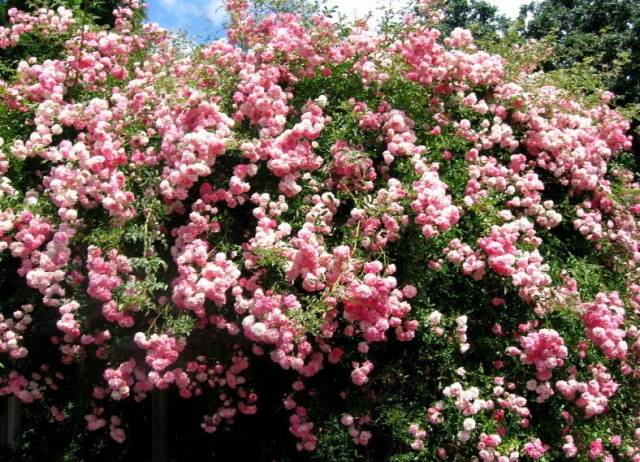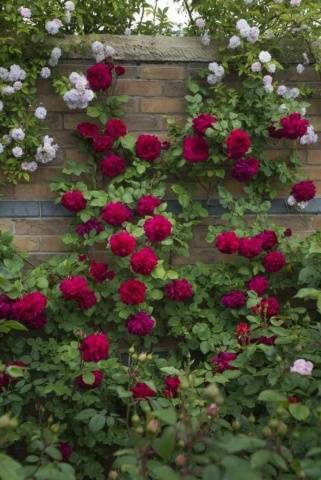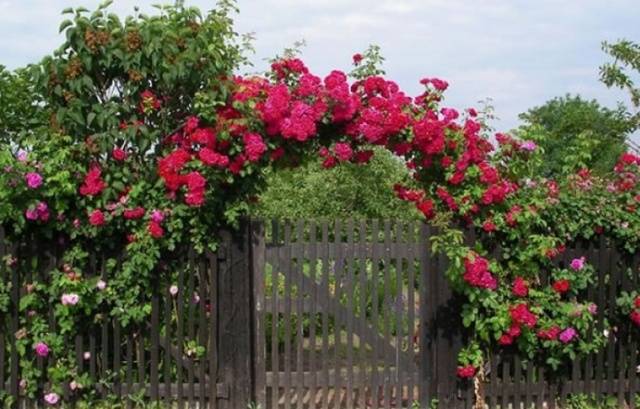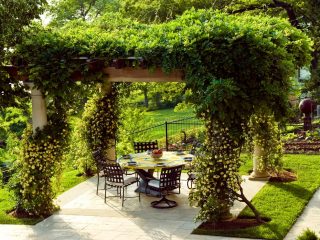Content
Roses have long been considered royal flowers. They were widely used for garden decoration, parks, garden plots. Of course, a few decades ago, flower growers had fewer opportunities to create a unique landscape. Modern lovers of rose bushes have a huge number of new varieties in their arsenal.
Thanks to the rich color palette and different lengths of the lashes, you can create any, the most original flower arrangements. Usually, climbing roses in landscape design they occupy a dominant position. The main thing is to choose a place, choose varieties and properly care for them.
Growing technology
When growing climbing roses you need to pay attention not only to the formation of buds, but also to the length of the lashes. Perfection can be achieved if you plant, prune and care for rose bushes correctly.
Planting roses
Before planting, seedlings of climbing varieties are soaked for 24 hours in a solution to develop the root system, then the roots and the entire plant are examined.
After pruning, the stems and roots of the future queen of flowers are sprinkled with wood ash.
A good seedling should have 3-5 shoots and strong roots.Any damage to the rose bushes is removed. The preparation rules are shown in the picture.
The climbing rose has special requirements for the soil: lightness, nutrition, and the ability to pass oxygen and water. You can add a little lime. To increase fertility, you can use humus, phosphorus fertilizers, and humus.
Climbing roses require a 50x50 hole up to 65 cm deep. At least 100 cm between bushes are important requirements for landscape designers. When planting seedlings, it should be taken into account that the root collar should be buried 10-12 cm. You need to dig holes under future supports, as in this photo, so that later during installation you do not damage the root system of the plant.
After planting, the soil around the climbing rose is lightly trampled and watered. Step-by-step instructions for planting roses to create a landscape design in a garden or country house are presented in the photo.
Further caring for climbing roses traditional: watering, fertilizing, pruning and preparing rose bushes for winter. Flower growers who have been working with climbing varieties for a long time do not always remove the vines from the support and bend them to the ground. Sometimes queens of the garden can spend the winter as in the photo.
Stages of creating landscape design
Layout
If you decide to seriously engage in climbing varieties, you need to think about where on the site the rose garden will be located. These types of climbing plants prefer sunny places, but without scorching sun. Direct sunlight has a detrimental effect on the plant itself, but, most importantly, the exoticism of the rose bush is lost.
When choosing a place to plant climbing roses, landscape designers suggest paying attention to shaded areas so that there is no wind there and the sun illuminates the rose bushes for no more than 6 hours. The picture shows the correct placement of rose bushes in a vertical landscape design.
Selection of plants
After you have created a rough landscape design plan, you need to select the appropriate varieties of the queen of the garden. You need to take into account the color scheme of climbing varieties. The color of the buds should be in harmony with each other.
According to the international classification, climbing roses are divided into three groups:
- They are distinguished by flexible, arched shoots 1.5-5 meters long. The shoots are always bright green with thorns. The color range is extensive. There are varieties with small and large flowers, double or simple, forming inflorescences. Flowering is abundant and long, sometimes up to a month. The small size of the flowers with abundant flowering gives the rose bush (see photo) harmony and grace. The leaves on rose bushes are dense, glossy, and small in size. Frost resistance is high; in light frosts they do well with light shelter.
- Plants of this group were obtained by crossing with remontant and hybrid tea varieties of roses. The shoots grow quickly and reach a length of 4 meters. The varieties belong to vines, they are called climbing roses. The buds are large and loose. The color palette is wide. Flowering can occur in two waves. The plants are winter-hardy and are little susceptible to diseases typical of climbing roses. These climbing queens in the photo are pure perfection.
- Some roses begin to mutate at certain times. And this happens on its own.But breeders choose the most exotic specimens and consolidate the properties of roses. This is how the third group appeared, which flower growers fell in love with. These hardy varieties of climbing plants with large buds and a variety of colors are an excellent material for designers. The lashes of climbing roses are long and powerful. But such queens of the garden begin to bloom later. Flower growers like this climbing varieties gave the name climbers. They look elegant in landscape design, as evidenced by the photo.
Popular varieties:
- Pierre de Ronsard, Flamentanz, Santana and Laguna;
- Cordes, Polka, Sympathy and Rosarium Jutersen;
- Climbing Peace, Aloha, Golden Perfume, Elf and others.
Roses in landscape design
Climbing roses are not quite vines, although they climb. They cling to support with their spikes. Arches, gazebos, and columns can be used as support. Plants on natural supports, such as trees in the garden, look good. Often used broom, rowan, yew. Having wrapped her lashes around a tree trunk, the queen holds herself perfectly, creating a unique picture.
Branches will subsequently form on each stem, on which fragrant buds will then bloom magnificently. Supports can have different shapes and sizes. Flower growers must choose the desired direction for the lashes. To decorate a house or balcony, bushes are planted at a distance of 45 from the wall.
After the shoots appear, they are directed in the right direction. Some of the lashes are tied horizontally, and the rest grow upward
This formation of a bush of climbing varieties is important for landscape design. With the help of rose bushes you can decorate the walls of houses and fences.Even the old fence is transformed, covered with bright, fragrant flowers. Look at the options in the photo.
Why not Monomakh's hat over the entrance to the house made of pink buds.
Hedges
As a rule, rose bushes attract attention. If you approach landscape decor with imagination, then while the queen of the garden is in bloom, outbuildings, garages, an unsightly fence or an old stump will “disappear” on the site. Garlands of climbing flowers will hide all the imperfections. An unusual flower arrangement called a hedge will appear.
In addition to the hedge fence, you can use trellises, wooden gratings, and metal mesh with large cells. Having dug two pillars, stretch the wire in several rows - the stylish wall is ready.
Options for using climbing roses for a living wall in landscape design in the photo.
If your fence is low and painted white, you can plant rose bushes with soft pink colors along it. This fence can be used to separate the work area from the garden. You will get a garden in the Provence style, as in the photo below.
Arches and pergolas for roses
Climbing roses are the best material for landscape design when decorating arches, small statues and trellises. Every person dreams of solitude, where they can daydream, collect their thoughts, or just relax. And blooming roses create a romantic atmosphere.
Arches can be located anywhere in the garden; they are often installed directly above the entrance to the yard. Such supports can be wooden, metal or even thick wire.
And as an addition - bushes and trees, various flowers. Although arches and pergolas are called classics of style, they occupy an important place in landscape design. Look at the pictures, what could be better!
Look at the photo below. What an amazing solution by landscape designers: a white arch and red climbing roses!
If you want the rose to entwine a pillar or arch, its shoots are arranged in a spiral, carefully twisted onto the support. Arch of climbing roses in the photo.
Video about climbing roses in landscape design:
In conclusion, useful tips
There is a reverent attitude towards climbing roses in landscape design. The Queen of the Garden helps create a romantic mood. The picture may become blurry if you make a mistake when choosing the color palette of climbing rose varieties. Colors should harmonize and not oppose each other.
Helpful Tips:
- White color is the most loyal. Next to white roses you can plant bushes with yellow and light blue flowers. It’s a good idea to dilute the composition with plants that have bluish foliage.
- Next to yellow roses, orange, blue, blue flowers look good,
- To rose bushes with bright orange and red buds, you can add plants with blue, light blue flowers or grass with yellow-green leaves.
- Roses with orange, apricot and peach shades of buds do not add anything. Otherwise they will lose their individuality.
- Varieties of red roses with orange or purple hues should be planted further apart.
Every person is a dreamer and experimenter by nature. Through trial and error, you can always find the zest in combining climbing roses with other plants.Create your own landscape design projects for your site and share with rose lovers, send unique photos.






































